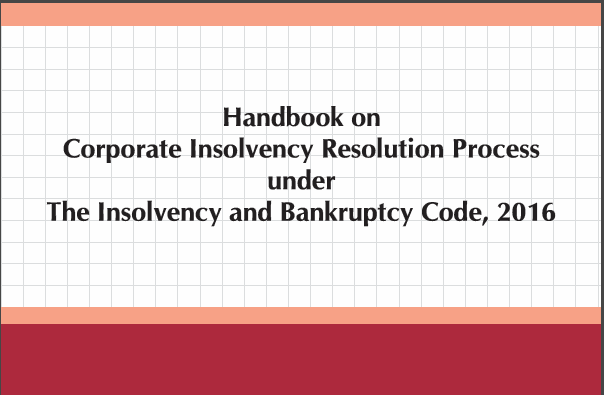Handbook on Corporate Insolvency Resolution Process under The Insolvency and Bankruptcy Code, 2016: ICAI
Chapter 1 Concept of Insolvency, Bankruptcy & Liquidation
The handbook will be useful for professionals, businesspersons, entrepreneurs, bankers, and consultants dealing with company matters.
It is a step-by-step guide for the implementation of the CIRP in accordance with the provisions of the IBC in simple language for easy understanding and comprehension.
Though the handbook may not follow the sequence of the IBC, its structure is designed in a way as to acquaint the beneficiaries of the process as it is supposed to be implemented.
The primary source of information of this handbook is the IBC, the regulations made thereunder, and the various case laws on the subject.
Now, before proceeding with the procedures and nuances of the Corporate Insolvency Resolution Process (CIRP), it will be worthwhile to understand the terms Insolvency, Bankruptcy, and Liquidation.
Related Topic:
The Provincial Insolvency Act, 1920
Insolvency
Insolvency is the state of a business of a debtor in which it is unable to pay its liabilities or has defaulted in the payment of its liabilities.
There are two types of insolvencies that form the basis for the initiation of rescue/reorganization/rehabilitation measures under insolvency laws.
Balance Sheet Insolvency: When the debtor’s assets are insufficient to meet its present and possible liabilities; i.e. though the debtor has not defaulted in its obligation to pay, but taking a complete view of the assets and liabilities, the latter far exceeds the former
It is a pre-emptive measure that leads to the invocation of the rehabilitation mechanism before the actual default by the debtor.
Related Topic:
Documents to be filed by Insolvency Professionals under IBC Law.
Cash Flow Insolvency: It is a situation where a debtor has actually defaulted in meeting its payment obligations. The assets of such debtor may be more than the liabilities, i.e., it may have positive net worth, but the cash position is such that it cannot meet its liabilities as and when they fall due.
Under the IBC, the cash-flow insolvency test, i.e., actual default in making obliged payments is applied to trigger the insolvency resolution process.
Related Topic:
Guide to CA Certificates in GST: ICAI
Bankruptcy
This term is used interchangeably with insolvency. However, in some legal jurisdictions, a distinction is made between these two terms.
In some jurisdictions, the term insolvency is associated with legal entities and bankruptcy with natural persons. In other jurisdictions, differentiation is that insolvency is a ‘state’ of inability to pay liabilities or failure to pay liabilities, whereas bankruptcy is a ‘status’ granted by law. Thus, bankruptcy is a ‘legal’ state of insolvency.
Yet another differentiation coined by practitioners is that what liquidation is to a corporate person, bankruptcy is to a natural person.
Related Topic:
Join our free webinar today (5 PM-6 PM) on Case Laws Covered in Limited Insolvency Examination by CA RK Gupta
Liquidation
Liquidation is the process of bringing a business to an end and distributing its assets to creditors. In IBC, it is one of the outcomes of the resolution process. If the resolution process fails, the debtor is ordered to be liquidated.
Chapter 2 Evolution of Insolvency Laws
The matters relating to Insolvency and Bankruptcy of persons and entities fall in the concurrent list (List-III of the seventh schedule) of the Constitution of India.
Constitution has empowered the Central and State Government to make the law about Insolvency and Bankruptcy matter in the list – III (concurrent list) of the seventh schedule of Constitution of India.
Therefore, both Central and State Governments have the power to make laws relating to this subject.
Related Topic:
Handbook on Resolution Plan under The Insolvency and Bankruptcy Code, 2016: ICAI
Related Laws existing before the advent of IBC:
For Incorporated entities (e.g. Companies):
- Companies Act, 1956, now Companies Act, 2013
- The Sick Industrial Companies (Special Provisions) Act, 1985 (SICA): To detect unviable (“sick”) or potentially sick companies and to help with their revival, if possible, or their closure, if not. It also provided for the setting up of the Board for Industrial and Financial Reconstruction (BIFR) and the Appellate Authority for Industrial and Financial Reconstruction (AAIFR). This Act was repealed with the enactment of IBC.
- The Recovery of Debts due to Banks and Financial Institutions Act, 1993: To provide for the establishment of Tribunals for expeditious adjudication and recovery of debts due to banks and financial institutions
- The Securitisation and Reconstruction of Financial Assets and Enforcement of Security Interest Act, 2002 (SARFAESI): To regulate securitization and reconstruction of financial assets and enforcement of security interest and to provide for a Central database of security interests created on property rights.
For individuals and unincorporated entities:
The Presidency Towns Insolvency Act, 1909: applicable in Presidency towns of Kolkata, Mumbai, and Chennai
The Provincial Insolvency Act, 1920: applicable in the rest of India
Committees of the Government
1. Tiwari Committee – recommended setting up of The Debt Recovery Tribunals (DRTs) and The Debt Recovery Appellate Tribunals (DRATs)
2. Narasimham Committee I & II – on Banking Sector Reforms
3. Justice Eradi Committee – to suggest reforms in the procedure followed in the insolvency proceedings
4. JJ Irani Committee – to advise the Government on the new Company Law
Bankruptcy Law Reforms Committee (BLRC)
The Bankruptcy Law Reforms Committee under the Chairmanship of Dr. T. K. Viswanathan submitted its report to the Finance Ministry on November 4, 2015.
The objectives of the Committee were to create a uniform framework that would cover matters of insolvency and bankruptcy of all legal entities and individuals.
The report of this committee formed the basis of the Insolvency and Bankruptcy Code, 2016.
Read & Download the full Copy in pdf:
If you already have a premium membership, Sign In.
 ConsultEase Administrator
ConsultEase Administrator
Consultant
Faridabad, India
As a Consultease Administrator, I'm responsible for the smooth administration of our portal. Reach out to me in case you need help.












